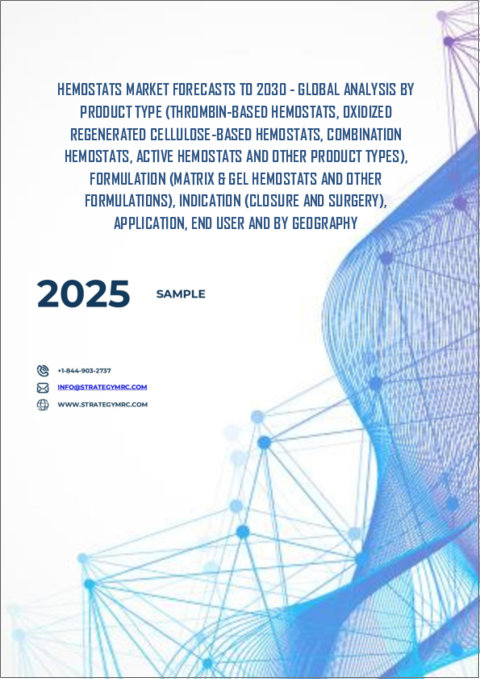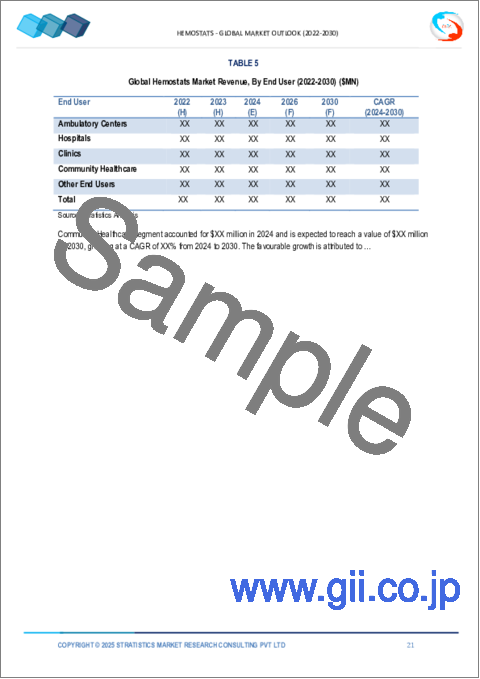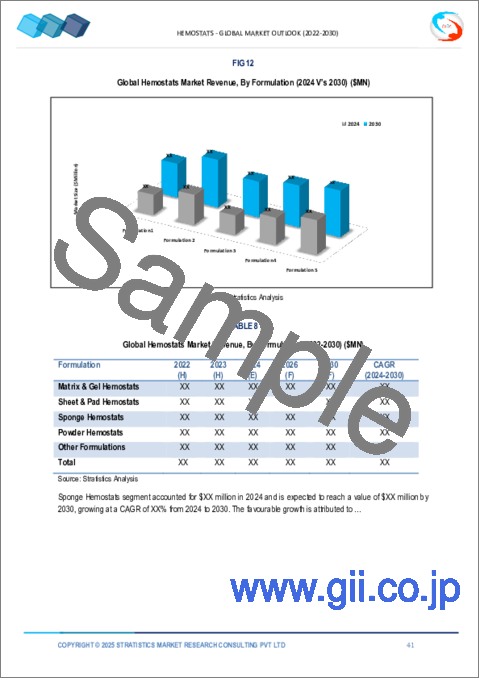|
|
市場調査レポート
商品コード
1383411
止血材市場の2030年までの予測:製品タイプ、製剤、適応症、用途、エンドユーザー、地域別の世界分析Hemostats Market Forecasts to 2030 - Global Analysis By Product Type, Formulation, Indication, Application, End User and By Geography |
||||||
カスタマイズ可能
|
|||||||
| 止血材市場の2030年までの予測:製品タイプ、製剤、適応症、用途、エンドユーザー、地域別の世界分析 |
|
出版日: 2023年11月01日
発行: Stratistics Market Research Consulting
ページ情報: 英文 200+ Pages
納期: 2~3営業日
|
- 全表示
- 概要
- 図表
- 目次
Stratistics MRCによると、世界の止血材市場は2023年に27億米ドルを占め、予測期間中のCAGRは8.7%で、2030年には48億米ドルに達する見込みです。
止血材は、血管、組織をクランプ、シール、または圧縮することによって出血を制御するために使用される医療器具です。止血材は、外科手術において、無血の術野を確保し、正確で安全な介入を助ける貴重な道具です。止血材は過剰な出血を防ぎ、手術中の出血や合併症のリスクを最小限に抑えます。
米国心臓協会が2020年7月に発表した報告書によると、米国における冠動脈バイパス移植術(CABG)の年間手術件数は約24万件です。
手術件数の増加
世界人口の増加と高齢化に伴い、心臓血管や整形外科手術から外傷やがん関連手術に至るまで、様々な医療分野にまたがる外科手術の需要が増加し続けています。止血材は、これらの手術中の出血をコントロールする上で重要な役割を果たし、患者の安全性と手術の成功に貢献しています。手術手技が進歩し、手術の選択肢が広がるにつれて、効果的で効率的な止血用具の必要性が顕著になっています。このような手術件数の増加は、止血を維持し、出血量を減らし、患者の転帰を改善する上で止血器具が果たす極めて重要な役割を強調しています。
緊急時の使用は限定的
止血材は外科手術中の出血をコントロールする上できわめて重要であるが、外傷治療や戦場医療のような迅速かつ高ストレスの救急場面では、その適用が制限されることがあります。このような場面では、瞬時に近い確実な止血が可能な止血材が必要とされます。複雑な適用手順や特殊な条件を必要とする止血材は、このような危機的状況の要求に応えられない可能性があります。このような制約を克服するためには、人命救助や重篤な出血の予防という一刻を争う緊急事態において、迅速かつ効果的に使用できるよう設計された特殊な止血材の開発が必要です。
ヘルスケアコスト削減
出血を最小限に抑え、輸血の必要性を減らし、手術時間を短縮することで、止血材はヘルスケア費用の削減に貢献します。これらの費用対効果の高いソリューションは、資源配分を改善し、術後合併症を減少させ、患者の転帰を向上させる。医療費抑制が最重要課題である環境において、臨床的有効性と経済的メリットの両方を提供する止血材製品は、このような機会に対応し、市場での牽引力を高める好位置にあります。
厳しい規制の変化
規制の進化や安全基準の強化は、止血材の承認、製剤化、商品化に影響を与える可能性があります。刻々と変化する規制への対応には時間とコストがかかり、市場参入の遅れや開発費の増加につながる可能性があります。課題は、製品の安全性と有効性を維持しながら、新たな要件に対応することにあります。規制の不確実性と包括的な文書化の必要性は、開発プロセスに複雑さを加えます。これらの要因はイノベーションを妨げ、新規止血ソリューションのイントロダクションを制限し、医療従事者や患者の進化するニーズに対応する市場の能力を低下させる可能性があります。
COVID-19の影響:
COVID-19の大流行は止血材市場にさまざまな影響を与えました。重要な手術や外傷治療において止血材の需要は引き続き高いが、パンデミックはサプライチェーンを混乱させ、一部の製品の入手性に影響を与えました。さらに、選択的な外科手術が延期または中止され、市場全体の需要が一時的に減少しました。ヘルスケア施設がCOVID-19治療に集中したため、止血を含む他の医療ニーズへの注目度は変動しました。しかし、堅牢なヘルスケア・インフラを維持することの重要性と緊急時の止血材の必要性がより明らかになり、医療システムが将来の課題に対応するために適応するにつれて、パンデミック後の市場の回復力が高まる可能性があります。
予測期間中、トロンビンベースの止血材セグメントが最大となる見込み
トロンビンベースの止血材セグメントは有利な成長が見込まれます。これらの製品には、血液凝固プロセスを開始する酵素であるトロンビンが含まれています。出血部位に適用すると、トロンビンベースの止血材は、可溶性フィブリノーゲンを不溶性フィブリン鎖に変換することによって血栓形成を促進し、最終的に安定した血栓の形成につながります。その汎用性により、心臓血管や整形外科手術から肝切除や外傷治療まで、幅広い外科手術に適しています。トロンビンベースの止血材は、出血を迅速かつ正確にコントロールし、出血やそれに伴う合併症のリスクを軽減します。トロンビン系止血材は、その止血効果において実績があることから、医療現場での信頼が厚く、止血材市場全体における存在感を高めています。
予測期間中にCAGRが最も高くなると予想されるのは病院セグメントです。
予測期間中、CAGRが最も速く成長すると予測されるのは病院分野です。大規模な学術医療センターから地域病院まで、これらの医療施設は、多様な外科手術中の出血を制御するために止血材に依存しています。止血材は、医療従事者が正確かつ安全に手術を行えるよう、無血の手術場を確保するために不可欠なツールです。選択的手術であれ緊急手術であれ、外科的介入に対する絶え間ない需要は、病院における止血材の重要性を強調しています。さらに、低侵襲手技を含む高度な手術手技の採用が、効果的な止血材の必要性をさらに高めており、病院は患者の安全、手術結果の成功、業務効率に継続的に重点を置いており、止血材市場の成長と開拓を推進しています。
最大のシェアを占める地域
予測期間中、北米市場が引き続き市場シェアの大半を占めると予想されます。同地域は、確立されたヘルスケアインフラ、高度な医療技術、外科手術の多さを誇っています。止血材および止血デバイスに対する需要は、心臓手術や整形外科手術から外傷治療に至るまで、さまざまな医療専門分野で一貫して高い水準を維持しています。厳格な規制基準と患者の安全性重視が、革新的な止血ソリューションの開発と採用を後押ししています。また、慢性疾患の蔓延と高齢化により、効果的な止血材のニーズがさらに高まっています。
CAGRが最も高い地域:
アジア太平洋地域は同市場において重要な役割を果たしており、予測期間中のCAGRは最も高いと予測されます。ヘルスケア投資の増加、医療インフラの拡大、患者人口の増加が、止血材および止血デバイスの採用に有利な環境を生み出しています。特に中国やインドなどの国々では、手術件数の増加に伴い、効果的な止血ソリューションに対する需要が高まっています。また、同地域では手ごろな価格のヘルスケアソリューションが重視され、医療ツーリズムの動向や医療へのアクセスも市場の成長を後押ししています。
無料カスタマイズサービス:
本レポートをご購読のお客様には、以下の無料カスタマイズオプションのいずれかを提供いたします:
- 企業プロファイル
- 追加市場プレイヤーの包括的プロファイリング(3社まで)
- 主要企業のSWOT分析(3社まで)
- 地域セグメンテーション
- 顧客の関心に応じた主要国の市場推計・予測・CAGR(注:フィージビリティチェックによる)
- 競合ベンチマーキング
- 製品ポートフォリオ、地理的プレゼンス、戦略的提携に基づく主要企業のベンチマーキング
目次
第1章 エグゼクティブサマリー
第2章 序文
- 概要
- ステークホルダー
- 調査範囲
- 調査手法
- データマイニング
- データ分析
- データ検証
- 調査アプローチ
- 調査ソース
- 1次調査ソース
- 2次調査ソース
- 前提条件
第3章 市場動向分析
- 促進要因
- 抑制要因
- 機会
- 脅威
- 製品分析
- 用途分析
- エンドユーザー分析
- 新興市場
- 新型コロナウイルス感染症(COVID-19)の影響
第4章 ポーターのファイブフォース分析
- 供給企業の交渉力
- 買い手の交渉力
- 代替品の脅威
- 新規参入業者の脅威
- 競争企業間の敵対関係
第5章 世界の止血材市場:製品タイプ別
- トロンビンベースの止血材
- 酸化再生セルロースベースの止血材
- 組み合わせ止血材
- フィブリンシーラント
- ゼラチンベースの止血材
- コラーゲンベースの止血材
- その他の製品タイプ
第6章 世界の止血材市場:製剤別
- マトリックスおよびゲル止血材
- シート&パッド止血材
- スポンジ止血材
- 粉末止血材
- その他の処方
第7章 世界の止血材市場:適応症別
- 閉鎖
- 手術
第8章 世界の止血材市場:用途別
- 整形外科
- 一般外科
- 神経外科
- 心臓血管外科
- 再建手術
- 婦人科外科
- 形成外科
- その他の用途
第9章 世界の止血材市場:エンドユーザー別
- 外来センター
- 病院
- クリニック
- 地域ヘルスケア
- その他のエンドユーザー
第10章 世界の止血材市場:地域別
- 北米
- 米国
- カナダ
- メキシコ
- 欧州
- ドイツ
- 英国
- イタリア
- フランス
- スペイン
- その他欧州
- アジア太平洋地域
- 日本
- 中国
- インド
- オーストラリア
- ニュージーランド
- 韓国
- その他アジア太平洋地域
- 南米
- アルゼンチン
- ブラジル
- チリ
- その他南米
- 中東とアフリカ
- サウジアラビア
- アラブ首長国連邦
- カタール
- 南アフリカ
- その他中東とアフリカ
第11章 主な発展
- 契約、パートナーシップ、コラボレーション、合弁事業
- 買収と合併
- 新製品の発売
- 事業拡大
- その他の主要戦略
第12章 企業プロファイル
- Ethicon, Inc
- Becton Dickinson and Company
- Marine Polymer Technologies, Inc
- Pfizer, Inc
- Johnson & Johnson Services, Inc
- Integra Lifesciences Corporation
- Hemostatis LLC
- Z-Medica LLC
- Medtronic plc
- Gelita Medical GmbH
- Stryker Corporation
- Baxter International, Inc
- Teleflex Incorporated
- Anika Therapeutics, Inc
- B. Braun Melsungen AG
- CR Bard, Inc.
List of Tables
- Table 1 Global Hemostats Market Outlook, By Region (2021-2030) ($MN)
- Table 2 Global Hemostats Market Outlook, By Product Type (2021-2030) ($MN)
- Table 3 Global Hemostats Market Outlook, By Thrombin-based Hemostats (2021-2030) ($MN)
- Table 4 Global Hemostats Market Outlook, By Oxidized Regenerated Cellulose-based Hemostats (2021-2030) ($MN)
- Table 5 Global Hemostats Market Outlook, By Combination Hemostats (2021-2030) ($MN)
- Table 6 Global Hemostats Market Outlook, By Fibrin Sealants (2021-2030) ($MN)
- Table 7 Global Hemostats Market Outlook, By Gelatin-based Hemostats (2021-2030) ($MN)
- Table 8 Global Hemostats Market Outlook, By Collagen-based Hemostats (2021-2030) ($MN)
- Table 9 Global Hemostats Market Outlook, By Other Product Types (2021-2030) ($MN)
- Table 10 Global Hemostats Market Outlook, By Formulation (2021-2030) ($MN)
- Table 11 Global Hemostats Market Outlook, By Matrix & Gel Hemostats (2021-2030) ($MN)
- Table 12 Global Hemostats Market Outlook, By Sheet & Pad Hemostats (2021-2030) ($MN)
- Table 13 Global Hemostats Market Outlook, By Sponge Hemostats (2021-2030) ($MN)
- Table 14 Global Hemostats Market Outlook, By Powder Hemostats (2021-2030) ($MN)
- Table 15 Global Hemostats Market Outlook, By Other Formulations (2021-2030) ($MN)
- Table 16 Global Hemostats Market Outlook, By Indication (2021-2030) ($MN)
- Table 17 Global Hemostats Market Outlook, By Closure (2021-2030) ($MN)
- Table 18 Global Hemostats Market Outlook, By Surgery (2021-2030) ($MN)
- Table 19 Global Hemostats Market Outlook, By Application (2021-2030) ($MN)
- Table 20 Global Hemostats Market Outlook, By Orthopedic Surgery (2021-2030) ($MN)
- Table 21 Global Hemostats Market Outlook, By General Surgery (2021-2030) ($MN)
- Table 22 Global Hemostats Market Outlook, By Neurological Surgery (2021-2030) ($MN)
- Table 23 Global Hemostats Market Outlook, By Cardiovascular Surgery (2021-2030) ($MN)
- Table 24 Global Hemostats Market Outlook, By Reconstructive Surgery (2021-2030) ($MN)
- Table 25 Global Hemostats Market Outlook, By Gynecological Surgery (2021-2030) ($MN)
- Table 26 Global Hemostats Market Outlook, By Plastic Surgery (2021-2030) ($MN)
- Table 27 Global Hemostats Market Outlook, By Other Applications (2021-2030) ($MN)
- Table 28 Global Hemostats Market Outlook, By End User (2021-2030) ($MN)
- Table 29 Global Hemostats Market Outlook, By Ambulatory Centers (2021-2030) ($MN)
- Table 30 Global Hemostats Market Outlook, By Hospitals (2021-2030) ($MN)
- Table 31 Global Hemostats Market Outlook, By Clinics (2021-2030) ($MN)
- Table 32 Global Hemostats Market Outlook, By Community Healthcare (2021-2030) ($MN)
- Table 33 Global Hemostats Market Outlook, By Other End Users (2021-2030) ($MN)
Note: Tables for North America, Europe, APAC, South America, and Middle East & Africa Regions are also represented in the same manner as above.
According to Stratistics MRC, the Global Hemostats Market is accounted for $2.7 billion in 2023 and is expected to reach $4.8 billion by 2030 growing at a CAGR of 8.7% during the forecast period. Hemostats are medical instruments used to control bleeding by either clamping, sealing, or compressing blood vessels, tissues, or vessels. They are valuable tools in surgical procedures to ensure a bloodless surgical field, aiding in accurate and safe interventions. Hemostats help prevent excessive blood loss, minimizing the risk of hemorrhage and complications during surgery.
According to a report published by American Heart Association in July 2020, the annual number of Coronary Artery Bypass Graft (CABG) surgeries is around 240,000 in the U.S. All these trends are expected to increase demand for hemostatic agents.
Market Dynamics:
Driver:
Rising number of surgical procedures
As the global population grows and ages, the demand for surgical interventions continues to increase, spanning various medical fields, from cardiovascular and orthopedic surgeries to trauma and cancer-related procedures. Hemostatic agents play a crucial role in controlling bleeding during these surgeries, contributing to patient safety and surgical success. With advancements in surgical techniques and a broader array of surgical options available, the need for effective and efficient hemostatic tools becomes more pronounced. This growing surgical volume underscores the pivotal role hemostats play in maintaining hemostasis, reducing blood loss, and improving patient outcomes.
Restraint:
Limited use in emergency settings
While hemostatic agents are crucial in controlling bleeding during surgical procedures, their applicability in rapid and high-stress emergency situations, such as trauma care and battlefield medicine, can be restricted. In these scenarios, there is a need for hemostatic products that offer near-instantaneous and reliable hemostasis. Hemostats that require complex application procedures or specific conditions may not meet the demands of these critical situations. Overcoming this restraint requires the development of specialized hemostatic solutions designed for quick and effective use in emergencies, where every moment counts in saving lives and preventing severe hemorrhage.
Opportunity:
Healthcare cost reduction
By minimizing blood loss, reducing the need for blood transfusions, and shortening surgical times, hemostatic agents contribute to lower healthcare expenses. These cost-effective solutions improve resource allocation, reduce postoperative complications, and enhance patient outcomes, which can ultimately translate to reduced hospitalization costs and healthcare expenditures. In an environment where healthcare cost containment is a paramount concern, hemostatic products that offer both clinical effectiveness and economic advantages are well-positioned to address this opportunity and gain traction in the market.
Threat:
Stringent regulatory changes
Evolving regulations and heightened safety standards can impact the approval, formulation, and commercialization of hemostatic products. Compliance with these ever-changing regulations can be time-consuming and costly, leading to potential delays in market entry and increased development expenses. The challenge lies in adapting to new requirements while maintaining product safety and efficacy. Regulatory uncertainties and the need for comprehensive documentation add complexity to the development process. These factors can hinder innovation, limit the introduction of novel hemostatic solutions, and potentially reduce the market's ability to address the evolving needs of healthcare providers and patients.
COVID-19 Impact:
The COVID-19 pandemic had a mixed impact on the hemostats market. While the demand for hemostatic agents remained high during critical surgeries and trauma care, the pandemic disrupted supply chains, affecting the availability of some products. Additionally, elective surgical procedures were postponed or canceled, temporarily reducing the overall market demand. As healthcare facilities focused on COVID-19 treatment, the attention to other medical needs, including hemostasis, fluctuated. However, the importance of maintaining a robust healthcare infrastructure and the need for hemostats in emergencies became more evident, potentially driving greater resilience in the market post-pandemic as healthcare systems adapt to meet future challenges.
The thrombin-based hemostats segment is expected to be the largest during the forecast period
The thrombin-based hemostats segment is expected to have a lucrative growth. These products contain thrombin, an enzyme responsible for initiating the blood clotting process. When applied to a bleeding site, thrombin-based hemostats accelerate clot formation by converting soluble fibrinogen into insoluble strands of fibrin, ultimately leading to the formation of a stable blood clot. Their versatility makes them suitable for a wide range of surgical procedures, from cardiovascular and orthopedic surgeries to liver resections and trauma care. Thrombin-based hemostats offer rapid and precise control over bleeding, reducing the risk of hemorrhage and associated complications. Their proven track record in achieving hemostasis continues to make them a trusted choice in the medical field, contributing to their prominence within the broader hemostats market.
The hospitals segment is expected to have the highest CAGR during the forecast period
The hospitals segment is anticipated to witness the fastest CAGR growth during the forecast period. These medical facilities, ranging from large academic medical centers to community hospitals, rely on hemostats to control bleeding during a diverse array of surgical procedures. Hemostatic agents are essential tools that ensure a bloodless surgical field, enabling healthcare providers to perform surgeries with precision and safety. The constant demand for surgical interventions, whether elective or emergency, underscores the importance of hemostats in hospitals. Moreover, the adoption of advanced surgical techniques, including minimally invasive procedures, further amplifies the need for effective hemostatic products, hospitals' ongoing focus on patient safety, successful surgical outcomes, and operational efficiency continues to drive the growth and development of the hemostats market.
Region with largest share:
During the forecast period, it is expected that the North American market will continue to hold a majority of the market share. The region boasts a well-established healthcare infrastructure, advanced medical technology, and a high volume of surgical procedures. The demand for hemostatic agents and devices remains consistently strong across various medical specialties, from cardiac and orthopedic surgeries to trauma care. Stringent regulatory standards and a focus on patient safety drive the development and adoption of innovative hemostatic solutions. Additionally, the prevalence of chronic diseases and an aging population further amplifies the need for effective hemostats.
Region with highest CAGR:
The Asia Pacific region plays a significant role in the market and is projected to have the highest CAGR over the forecast period. The increasing healthcare investments, expanding healthcare infrastructure, and a growing patient population create a favorable environment for the adoption of hemostatic agents and devices. With rising surgical volumes, particularly in countries like China and India, the demand for effective hemostatic solutions is on the ascent. Additionally, the region's focus on affordable healthcare solutions, growing trend of medical tourism and access to medical care drives the market's growth.
Key players in the market
Some of the key players in Hemostats market include: Ethicon, Inc, Becton Dickinson and Company, Marine Polymer Technologies, Inc, Pfizer, Inc, Johnson & Johnson Services, Inc, Integra Lifesciences Corporation, Hemostatis LLC, Z-Medica LLC, Medtronic plc, Gelita Medical GmbH, Stryker Corporation, Baxter International, Inc, Teleflex Incorporated, Anika Therapeutics, Inc, B. Braun Melsungen AG and CR Bard, Inc.
Key Developments:
In August 2023, Teleflex Incorporated (US) received US FDA clearance for the expanded indication for QuikClot Control+ in cardiac surgical procedures.
In July 2023, Baxter International (US) launched its PERCLOT Absorbable Hemostatic Powder in the US. This will allow the company to provide surgeons with a full range of active and passive hemostatic products for bleeding control, helping to optimize care for patients.
Product Types Covered:
- Thrombin-based Hemostats
- Oxidized Regenerated Cellulose-based Hemostats
- Combination Hemostats
- Fibrin Sealants
- Gelatin-based Hemostats
- Collagen-based Hemostats
- Other Product Types
Formulations Covered:
- Matrix & Gel Hemostats
- Sheet & Pad Hemostats
- Sponge Hemostats
- Powder Hemostats
- Other Formulations
Indications Covered:
- Closure
- Surgery
Applications Covered:
- Orthopedic Surgery
- General Surgery
- Neurological Surgery
- Cardiovascular Surgery
- Reconstructive Surgery
- Gynecological Surgery
- Plastic Surgery
- Other Applications
End Users Covered:
- Ambulatory Centers
- Hospitals
- Clinics
- Community Healthcare
- Other End Users
Regions Covered:
- North America
- US
- Canada
- Mexico
- Europe
- Germany
- UK
- Italy
- France
- Spain
- Rest of Europe
- Asia Pacific
- Japan
- China
- India
- Australia
- New Zealand
- South Korea
- Rest of Asia Pacific
- South America
- Argentina
- Brazil
- Chile
- Rest of South America
- Middle East & Africa
- Saudi Arabia
- UAE
- Qatar
- South Africa
- Rest of Middle East & Africa
What our report offers:
- Market share assessments for the regional and country-level segments
- Strategic recommendations for the new entrants
- Covers Market data for the years 2021, 2022, 2023, 2026, and 2030
- Market Trends (Drivers, Constraints, Opportunities, Threats, Challenges, Investment Opportunities, and recommendations)
- Strategic recommendations in key business segments based on the market estimations
- Competitive landscaping mapping the key common trends
- Company profiling with detailed strategies, financials, and recent developments
- Supply chain trends mapping the latest technological advancements
Free Customization Offerings:
All the customers of this report will be entitled to receive one of the following free customization options:
- Company Profiling
- Comprehensive profiling of additional market players (up to 3)
- SWOT Analysis of key players (up to 3)
- Regional Segmentation
- Market estimations, Forecasts and CAGR of any prominent country as per the client's interest (Note: Depends on feasibility check)
- Competitive Benchmarking
- Benchmarking of key players based on product portfolio, geographical presence, and strategic alliances
Table of Contents
1 Executive Summary
2 Preface
- 2.1 Abstract
- 2.2 Stake Holders
- 2.3 Research Scope
- 2.4 Research Methodology
- 2.4.1 Data Mining
- 2.4.2 Data Analysis
- 2.4.3 Data Validation
- 2.4.4 Research Approach
- 2.5 Research Sources
- 2.5.1 Primary Research Sources
- 2.5.2 Secondary Research Sources
- 2.5.3 Assumptions
3 Market Trend Analysis
- 3.1 Introduction
- 3.2 Drivers
- 3.3 Restraints
- 3.4 Opportunities
- 3.5 Threats
- 3.6 Product Analysis
- 3.7 Application Analysis
- 3.8 End User Analysis
- 3.9 Emerging Markets
- 3.10 Impact of Covid-19
4 Porters Five Force Analysis
- 4.1 Bargaining power of suppliers
- 4.2 Bargaining power of buyers
- 4.3 Threat of substitutes
- 4.4 Threat of new entrants
- 4.5 Competitive rivalry
5 Global Hemostats Market, By Product Type
- 5.1 Introduction
- 5.2 Thrombin-based Hemostats
- 5.3 Oxidized Regenerated Cellulose-based Hemostats
- 5.4 Combination Hemostats
- 5.5 Fibrin Sealants
- 5.6 Gelatin-based Hemostats
- 5.7 Collagen-based Hemostats
- 5.8 Other Product Types
6 Global Hemostats Market, By Formulation
- 6.1 Introduction
- 6.2 Matrix & Gel Hemostats
- 6.3 Sheet & Pad Hemostats
- 6.4 Sponge Hemostats
- 6.5 Powder Hemostats
- 6.6 Other Formulations
7 Global Hemostats Market, By Indication
- 7.1 Introduction
- 7.2 Closure
- 7.3 Surgery
8 Global Hemostats Market, By Application
- 8.1 Introduction
- 8.2 Orthopedic Surgery
- 8.3 General Surgery
- 8.4 Neurological Surgery
- 8.5 Cardiovascular Surgery
- 8.6 Reconstructive Surgery
- 8.7 Gynecological Surgery
- 8.8 Plastic Surgery
- 8.9 Other Applications
9 Global Hemostats Market, By End User
- 9.1 Introduction
- 9.2 Ambulatory Centers
- 9.3 Hospitals
- 9.4 Clinics
- 9.5 Community Healthcare
- 9.6 Other End Users
10 Global Hemostats Market, By Geography
- 10.1 Introduction
- 10.2 North America
- 10.2.1 US
- 10.2.2 Canada
- 10.2.3 Mexico
- 10.3 Europe
- 10.3.1 Germany
- 10.3.2 UK
- 10.3.3 Italy
- 10.3.4 France
- 10.3.5 Spain
- 10.3.6 Rest of Europe
- 10.4 Asia Pacific
- 10.4.1 Japan
- 10.4.2 China
- 10.4.3 India
- 10.4.4 Australia
- 10.4.5 New Zealand
- 10.4.6 South Korea
- 10.4.7 Rest of Asia Pacific
- 10.5 South America
- 10.5.1 Argentina
- 10.5.2 Brazil
- 10.5.3 Chile
- 10.5.4 Rest of South America
- 10.6 Middle East & Africa
- 10.6.1 Saudi Arabia
- 10.6.2 UAE
- 10.6.3 Qatar
- 10.6.4 South Africa
- 10.6.5 Rest of Middle East & Africa
11 Key Developments
- 11.1 Agreements, Partnerships, Collaborations and Joint Ventures
- 11.2 Acquisitions & Mergers
- 11.3 New Product Launch
- 11.4 Expansions
- 11.5 Other Key Strategies
12 Company Profiling
- 12.1 Ethicon, Inc
- 12.2 Becton Dickinson and Company
- 12.3 Marine Polymer Technologies, Inc
- 12.4 Pfizer, Inc
- 12.5 Johnson & Johnson Services, Inc
- 12.6 Integra Lifesciences Corporation
- 12.7 Hemostatis LLC
- 12.8 Z-Medica LLC
- 12.9 Medtronic plc
- 12.10 Gelita Medical GmbH
- 12.11 Stryker Corporation
- 12.12 Baxter International, Inc
- 12.13 Teleflex Incorporated
- 12.14 Anika Therapeutics, Inc
- 12.15 B. Braun Melsungen AG
- 12.16 CR Bard, Inc.






